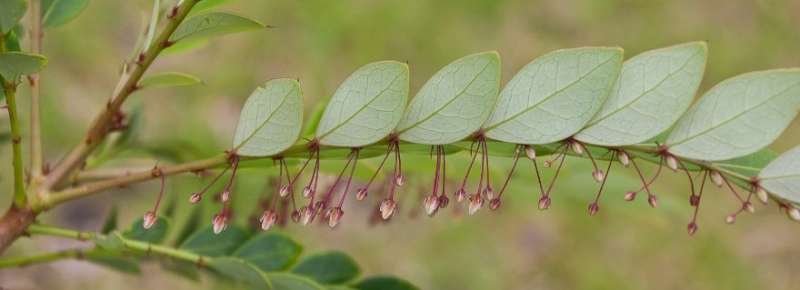Green miner—new plant species mines metal

A plant that takes metal from the ground all by itself: a natural way to mine or to clean the soil. Ph.D. student Roderick Bouman (Hortus Botanicus Leiden) described a new plant species from Sabah, Borneo, which can be used to extract nickel. In an open access article in Botanical studies, he and the other authors present the new species: Phyllanthus rufuschaneyi.
"The species was found in the wild already in 2013 and planted in a small garden near a reserve," says Bouman. Here the plant attracted attention because of its excellent ability to absorb nickel from the soil. For this reason the plant was involved in research on agromining: the extraction of metal from the soil with the aid of plants. "There are several possible applications," Bouman explains, 'for example extracting metals from areas where they occur naturally in high concentrations. It can also be used for cleaning old mining areas that are now polluted with metals. The plants are planted and harvested after a while, so that the metals are also taken out of the ground."
Researcher Antony van der Ent (University of Queensland) had been working with the plant for a while and suspected he was dealing with a new species. Because the plant achieved such good result as metal extractor, it was important for him to provide the plant with a proper identification. That is why he called in the help of Bouman and his supervisor Peter van Welzen. "We compared the specimens of Van der Ent with species that we already know from Borneo. Because it did not match anything, we decided to describe it as a new species," says Bouman.
The plant belongs to the genus Phyllanthus, a diverse genus of nearly 900 species. The different species are mainly distinguished on the basis of the flowers. "What makes this genus so fun to work with, is its diversity. Many researchers find the species difficult to identify, because the flowers are often very small and there are just many different species. With my research we try to better understand the structure of the group and also look at its distribution history and metabolites."
Van Welzen worked on the taxonomic description, Van der Ent performed the metal analyses and Bouman determined where to place the plant in the taxonomic classification. It stood out that the flowers had many properties of several other Phyllanthus species. That made it difficult to place the species in a certain group. The group where the plant was ultimately placed has been chosen based on the nectar winches. DNA research still has to confirm whether this placement is correct.
The researchers decided to name the plant Phyllanthus rufuschaneyi after Rufus Chaney. Chaney is a retired researcher who has worked for years on developing argomining. It therefore seemed an appropriate choice. "We asked for his permission and he felt very honored," adds Bouman.
More information: Roderick Bouman et al. Phyllanthus rufuschaneyi: a new nickel hyperaccumulator from Sabah (Borneo Island) with potential for tropical agromining, Botanical Studies (2018). DOI: 10.1186/s40529-018-0225-y
Provided by Leiden University















